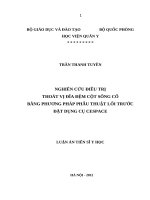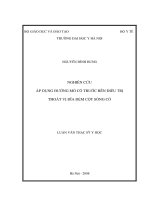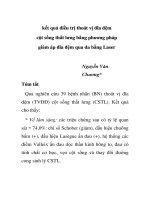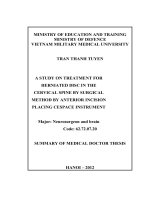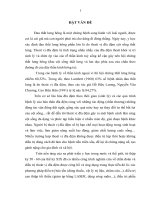nghiên cứu điều trị thoát vị đĩa đệm cột sống cổ bằng phẫu thuật lối trước đặt dụng cụ cespace bản tóm tắt tiếng anh
Bạn đang xem bản rút gọn của tài liệu. Xem và tải ngay bản đầy đủ của tài liệu tại đây (223.44 KB, 42 trang )
MINISTRY OF EDUCATION AND TRAINING
MINISTRY OF DEFENCE
VIETNAM MILITARY MEDICAL UNIVERSITY
TRAN THANH TUYEN
A STUDY ON TREATMENT FOR
HERNIATED DISC IN THE
CERVICAL SPINE BY SURGICAL
METHOD BY ANTERIOR INCISION
PLACING CESPACE INSTRUMENT
Major: Neurosurgeon and brain
Code: 62.72.07.20
SUMMARY OF MEDICAL DOCTOR THESIS
HANOI – 2012
THE WORK IS COMPLETED IN VIETNAM
MILITARY MEDICAL UNIVERSITY
Scientific Advisor:
A.P. Ph.D VO TAN SON
Panellist 1: Tran Manh Chi
Panellist 2: Nguyen Tho Lo
Panellist 3: Ha Kim Trung
The thesis will be defended against the council of the
thesis defense at 8.30 of 26 July 2012
The thesis can be found at:
- The national library
- The library of Vietnam Military Medical University
QUESTION
Herniated disc in the cervical spine is a disease caused
by disc degeneration and herniation in the cervical spine,
spines created by degradation pinching neck marrow or
nerve root cause. This disease is often characterized by
neck pain, shoulder pain or pain in the spinal nerve roots.
Therefore, this disease reduces nerve function, thereby
reducing the ability to work and quality of life.
Treatment for herniated disc in the cervical spine is for
the purpose of recovery of nerve function, and reducing
pain so the patient returns to normal life with quality. The
treatment is also very diverse, from physical therapy
methods and internal medicine. When internal medicine
treatment fails or neurological signs appear, it will be
treated with surgery. About classics, anterior incision
surgical treatments welds disc in associated with vertebral
body bone from autologous iliac crest, but this method
has disadvantages such as: requiring another surgery,
prolonged surgical time, falling bone graft causing
cervical spine hunchback or complications in the bone
graft. Thus, there have been many methods of improved
surgery and the latest surgical procedures by taking the
disc stem and joint welding using artificial materials such
as carbon fiber, titanium, PEEK has showed effective
results such as pain treatment and prevention of
complications after surgery, such as narrow
foramen intervertebrale leading to the cervical spine
hunchback. Nowadays, many devices with different
materials are used and it is difficult to prove the
preeminence of a device or materials over the others.
Selection depends on the familiarity and availability, cost
and high compatibility of the materials used.
In the Department of neurosurgeon of People's
Hospital 115, tools Cespace with Titanium which are
quite common in Vietnam at reasonable price and high
inertness are often used. So we made the topic "Research
on treatment of herniated disc in the cervical spine by
way of anterior incision surgery method of placing
tools Cespace."
Research objectives:
1. To determine some standards for surgical
indications in the treatment of disc herniation in the
cervical spine by way of anterior incision surgery and
placing tools Cespace.
2. To assess results of treatment of herniated disc in
the cervical spine by way of anterior incision surgery
using operating microscope and placing tools Cespace.
New contributions of the thesis:
Treatment for Herniated disc in the cervical spine by
way of anterior incision surgery and placing tools
Cespace has good results and can be easily implemented
to apply multiple layers of new patients using operating
microscope which helps main dissection, good blood
holding to avoid complications during and after surgery.
The layout of the thesis:
The thesis consists of 109 pages with 27 tables, 21
charts and 41 figures. The thesis constitutes the basic 4
chapters: Introduction 2 pages, Chapter 1 – Overview 29
Pages, Chapter 2 - Subjects and Methods 17 pages,
Chapter 3 - Research Results 29 Pages , Chapter 4 –
Discussion 29 pages, Conclusions 2 pages and
Recommendations 1 page; references 122 (28
Vietnamese, 94 English), including material published
from 2005 to present.
CHAPTER 1 - OVERVIEW
1.1. DIAGNOSIS
Need to study case history thoroughly, examine
clinically and radiology should be done to confirm the
diagnosis
The diagnostic tests are suggested:
- Spurling test solution.
- Pulling the neck by hand can be regarded as a
physical examination, the patient in the position of back
neck, gently pulling by hand often significantly reduces
symptoms in the neck and hands in patients with
pathological root.
- Shoulder stretch measure.
- L'hermitte signs found in patients with neck marrow
related diseases
1.2. RADIOLOGY
Radiology diagnosis is used to determine: whether or
not there is injury; lesion location, lesion extent, lesion
nature.
1.2.1. Conventional X-ray
Cervical spine radiographs are radiology diagnostic
method which is the first choice for patients with
symptoms of pain in the neck, spreading to limbs and
often used to diagnose neck disc diseases causing
symptoms of root nerve.
Tilt radiographs: to evaluate the disc slot height,
spines at the anterior and rear borders of the vertebral
body and the curvature of the cervical spine.
45
0
oblique radiographs: see foramen intervertebrale
at suspected positions of pathological root, compared to
contralateral foramen intervertebrale, articular facet and
zygapophysus.
1.2.2. Computerized tomography (CT Scanner)
CT examines bone composition and is useful in the
assessment of adduction fracture. It is also useful when
C6 and C7 are not visible on X-ray of tilt cervical spine.
The accuracy of the cervical spine CT limits from 72% -
91% in the diagnosis of disc herniation. The accuracy
reaches 96% when combined CT with electrospinogram,
which allows view of the subarachnoid space and
evaluation of the spinal marrow and nerve roots.
Computerized tomography with contrastmedium
injected into the spinal canal: CT capture technique
with contrastmedium injected into subarachnoid space is
considered to be good assessment and positioning of neck
marrow compression. In some cases, especially, of
invasion of foramen intervertebrale and lateral surface,
cross-sectional images reconstruct 3D very well.
1.2.3. Magnetic resonance imaging (MRI)
As soft tissues provided by MRI is visible, CT is
replaced by MRI for most cervical spine diseases.
MRI has now become the first choice method to
diagnose symptoms of neck root or symptoms of
combined marrow.
1.2.4. Electromyogram (EMG) (only when there is a
movement disorder)
Little was done, however, they also provide evidence of
root compression in patients at little clinical presentation.
1.3. TREATMENT OF HERNIATED DISC IN
THE CERVICAL SPINE (HDITCS)
Treatment methods of HDITCS now include: internal
medical treatment, surgical treatment and non-surgical
interventions.
1.3.1. Internal medical treatment
Internal medical treatments of HDITCS include:
Immovability: an important stage, immovability of
neck is completely maintained, at least during the period
of severe pain, often 3-4 weeks, with limited neck
movement and stay in bed wearing a neck fixed belt.
Most commonly used drugs are non-steroidal anti-
inflammatory anodyne, muscle relaxants, other
painkillers or steroids.
Other methods such as using heat in place, stretching
the cervical spine are also good practice to avoid
paramyotonus, only for simple root compression. There
are also stimulation by small electrical current,
acupressure, acupuncture but with limited efficacy.
1.3.2. Surgical treatment
* Surgical indications
The authors have indicated that surgical indications
should be based on two factors of clinic and radiology, in
which clinical plays an important role. Most authors
recommend surgical indications when one of the
following occurs:
- Constant pain, not responding to conservative treatment
(3-6 months).
- Progressive muscle weakness or muscle atrophy
already.
- There is a presence, or appearance, or increase of
symptoms of myelopathy.
1.3.2.1. Surgery of herniated disc in the cervical spine by
Anterolateral incision
- Smith and Robinson methods.
- Cloward method.
- Bailley and Badley method.
1.3.2.2. Herniated disc surgery by rear incision
Rear surgery is done according to the following three
main techniques: Cutting rear arcus, spinal canal plasty,
taking disc through foramen intervertebrale.
1.3.2.3. Coordinate neck anterolateral incision and rear
incision
In some cases, especially as HDITCS with longitudinale
ligament ossification following canalis spinalis stenosis
or canalis spinalis stenosis by back cause, an incision is
often not enough to release compression, the combination
of two anterior and rear incisions is necessary. For the
anterior incision, implementation techniques may be
removing vertebral bodies or merely taking disc,
releasing compression through hernia. For the rear
incision common techniques are spinalis stenosis plasty
or cutting rear arcus to release compression.
1.3.3. The method of minimal intervention treatment
1.3.3.1. Chemonucleolysis
Suggested by Lyman in 1963, Chymopapain or Aprotinin
(trasylon) injection into the disc to differentiate disc
nucleus pulposus has been widely used in France and
America in the 1970s and 1980s. This method is
endicated for HDITCS causing recurrent persistent neck
root pain with aggressive medical therapy for weeks
without improvement. Contraindicated in cases of
sequestration hernia, a large block, marrow compression,
transdural, herniated disc with neck canalis spinalis
stenosis, heavily degenerative disc and especially when
detecting vascular taken into loops on disc.
1.3.3.2. Percutaneous Laser Disc Decompression
It was first implemented in 1986 by Choy and Ascher.
Based on the principle of using laser energy to ignite a
small volume of mucus, thus reducing the pressure inside
the disc suddenly, making the herniated disc shrink,
reducing nerve root compression. Although it was a
method of minimal intervention, but it also has very tight
indications of treatment.
1.3.3.3. Percutaneous disc decompression using radio
waves
This method was implemented by Singh and Derby for
the first time in 2001. Using radio waves to create a
picture of the mucous disc using coblation technology
(this method is called nucleoplasty). Nucleoplasty is a
minimally invasive technique to reduce the pressure
inside the disc using coblation technology community.
1.3.3.4. Surgical endoscopic microsurgery disc
Endoscopic has been applied to surgery of herniated disc
for a long time. In 1986, Schreiber used endoscopic
instruments to improve techniques of percutaneous disc
taking by Hijikata.The author used 2 lines: a line to get
the disc, the other opposite line to put endoscopic
instruments. These techniques allow observation of
herniated discs and nerve roots in the canalis spinalis.
CHAPTER - SUBJECTS AND METHODS OF
RESEARCH
2.1. SUBJECTS OF RESEARCH
2.1.1. Researched patients
Including 89 patients diagnosed herniated disc in the
cervical spine, under surgical treatment in People's
Hospital 115 from April - 2007 to November - 2010
2.1.2. Criteria for selection of patients
- Patients with a herniated disc in the cervical spine from
one to two layers with clinical syndrome of root or
marrow compression or root-marrow compression
syndrome and are diagnosed with appropriate images.
- Clear addresses (for easy follow-up)
- Adults, no muscle pathology.
- All patients were explained and consented to placement
of Cespace after getting disc, spine to decompress
marrow and root.
- 12-month follow-up period.
2.1.3. Exclusion criteria
- All patients with myelopathy due to degenerative neck
canalis spinalis stenosis and ligamentum longitudinale
posterius ossification of three layers or more.
- Patients with severe medical conditions such as severe
heart failure, progressive tuberculosis and under 16
years of age.
- Addresses are not clear.
2.2. METHODS OF RESEARCH
2.2.1. Research Design
Research Method: To describe the clinical, cross-
sectional, not controlled study.
2.2.2. Sample size
We use the calculation formula of sample size:
In which: n: Minimum sample size with Z
(1-/2)
= 1,96
(= 0.05)
p: estimated proportion of the target population, p =
3.5% (according to SalemiG)
p = 0.035, q = 1 – p p = 0.965; d (Estimated
deviation) = 5%
Therefore n ≥52 in reality, 89 cases are collected.
2.3. USED MATERIALS
2.3.1. Researched Materials Cespace
Cespace graft: basic elements of cervical inter-
vertebral graft are solid Titanium core, this core is filled
with microporous Plasmapore material to increase the
surface area by 16 times, thereby increasing the contact
area between the graft living with canalis spinalis.
2.3.2. Surgical Instruments
People's Hospital 115 is currently using specialized
microsurgical system dedicated for neurosurgery: Leica
MS3 M520 manufactured by Federal Republic of
Germany.
2.4. EVALUATION CRITERIA AFTER
SURGERY HERNIATED DISC IN THE CERVICAL
SPINE WITH CESPACE
Evaluation criteria are based on the general scale of
Japan Orthopedic Association (JOA) and radiology
- Recovery rate (RR) has the maximum point
according to JOA: 17:
o Exercise: upper limb movement disorder (4 points),
lower limb movement disorder (4 points)
o Sensation: upper limb (2 points), lower limb (2
points), body (2 points)
o Sphincter function (3 points)
RR = (JOA
postoperative or re-examination
– JOA
preoperative
) x 100/
(17 – JOA
preoperative
)
Recovery rate: 75% very good
50% good
20% acceptable
20% bad
- Pre-and postoperative evaluation of radiograph:
shooting in four positions: straight, tilt and right oblique
and left oblique. Tilt position is used to assess height of
disc, degenerative spine and physiological curves of the
cervical spine. Right and left oblique positions is used to
assess foramen intervertebrale, articular facet
andzygapophysus. Radiograph is used to assess the
cervical spine stiffness and bone welding.
- Evaluation of spinal hyperextension: draw a straight
line from the rearest point of tip to posterior inferior point
of the C7 body, measure the distance from this line to the
posterior inferior border of the body of C4, this gap
normally # 11.8 mm ± 5.
- Evaluate Cespace settlement in two adjacent
vertebral bodies: measuring height of disc slot/ height of
Cespace if <0.7 mm there is settlement.
2.5. SURGICAL TREATMENT
Indications for surgery:
- Pain in shoulders neck, arms which is continuously
recurrent and does not respond to medical therapy
- Progressive muscle weakness or muscle atrophy
already (root compression syndrome)
- There is the presence, or appearance or increase of
symptoms of marrow (marrow compression syndrome)
- Radiograph diagnosis: There is an image of disc
herniation, canalis spinalis stenosis caused by spines
leading to root or marrow compression in accordance
with clinical syndrome.
Surgical methods:
We apply surgery by Anterolateral incision (by the
method of Smith - Robinson) to place Cespace
2.6. CRITERIA FOR INSPECTION AFTER
SURGERY
Evaluate postoperative results based on changes in
clinical signs, early postoperative imaging, the results
will be after almost 3-6 months in short and 12 months in
long.
Evaluating of clinical signs such as pain, RLCG,
RLVD, RLCT, root HCCE and marrow HCCE thereby
calculating points according to JOA score and calculating
the recovery rate (RR)
Postoperative imaging:
- Evaluation of spinal hyperextension on tilt cervical
spine radiographic
- The welding of bones based on the motive cervical
spine radiographs
- The level of release of compression on MRI film.
2.7. RESEARCH ETHICS
- The subject is approved and agreed by Council of
Science and Technology of People's Hospital 115
- The subject is agreed by the Council of Research
Studentof Military Medical Academy to conduct research
- Patients are explained and agree to cooperate.
2.8. DATA PROCESSING
Data in the study is processed by statistical methods:
statistical tables, diagrams, using Stata software
programs, treatment results are evaluated after 1 year of
tracking.
CHAPTER 3 – FINDINGS
Our study was conducted on 89 patients with disc
herniation in the cervical spine with root compression
syndrome, marrow compression syndrome and marrow-
roots compression syndrome who were surgically treated
in People’s Hospital 115 from April 2007 to November
2010. All patients had imaging diagnosis consistent with
clinical standards and sampling criteria. The results are as
follows:
3.1. EPIDEMIOLOGY
3.1.1. Distribution of patients according to age (n =
89)
Average age: 51.58 ± 10:13, minimum 34, maximum
85 years old and the most common age 40-50 years old.
3.1.2. Distribution by sex
In our study plots male patients approximate to
female patients, 46 male patients (51.69%), 43 female
patients (48.31%).
3.1.3. Distribution by occupation
Table 3.1. Distribution by occupation (n = 89)
Occupation No. of
patients
Ratio
%
Office workers 29 32.58
Workers 19 21.34
Farmers 14 15.73
Retirement 15 16.85
Housewife 12 13.48
Comment: The highest rate is of office workers (32.58%)
3.1.4. Distribution by history
Table 3.2. Distribution by history (n = 89)
History No. of p. Ratio %
There are injuries (head, neck) 9 10.11
No injuries 80 89.89
Comment: The majority had no history of trauma
(89.89%).
3.2. CLINICAL SYMPTOMS BEFORE
SURGERY
3.2.1. Clinical signs of root disease
Table 3.3. Clinical symptoms of root disease (n = 24)
Symptoms No of
p.
Ratio
%
Neck pain 24 100
Pain and radicular paresthesias 24 100
Hand dexterity reduction 14 58.33
Weak hands 7 29.16
Muscle atrophy 2 8.33
Spurling test 19 79.16
Comment: neck pain and pain spread by roots
(100%), Spurling test is in the majority of root diseases
(79.16%).
3.2.2. Clinical signs of myelopathy
Table 3.4. Clinical signs of myelopathy (n = 65)
Symptoms No. Ratio %
Neck pain 60 92.31
Headache 18 27.69
Increased tendon reflexes 63 96.92
Hand dexterity reduction 18 27.69
Difficult walking 31 47.69
Micturition disorder 15 23.07
Weak quadriplegic 1 1.53
Comment: The increased tendon reflexes up to
96.92%, neck pain 92.31%.
3.3. IMAGING DIAGNOSIS
3.3.1. Routine X-ray
Table 3.5. Routine radiography (n = 89)
X-ray image
No. of p. Ratio %
Loss of physiological curve 58 65.16
Narrow disc slit 21 23.59
Narrow foramen intervertebrale 19 21.34
Spine 29 32.58
Total 89 100
Comment: The loss of physiological curves is up to 58
patients (65.16%).
3.3.2. The bending of the spine before and after
surgery on the tilt cervical spine radiographs
Table 3.6. Bending index before and after surgery (n
= 89)
Bending
(mm)
Before surgery After surgery
No.
Ratio
%
No. Ratio %
≤0 11 12.36 5 5.62
0<n<6 47 52.81 5 5.62
6≤n≤16 28 31.46 73 82.02
>16 3 3.37 6 6.74
Comment: after 12 months no circumstances were
humpbacked.
3.3.3. Magnetic Resonance
Table 3.7. Layer of herniation by magnetic resonance
images (n = 88)
The image on magnetic resonance
film
No. Ratio %
C
5
C
6
37 40.09
C
4
C
5
, C
5
C
6
14 15.91
C
4
C
5
11 13.63
C
3
C
4
10 11.36
C
6
C
7
7 7.95
C
3
C
4
, C
4
C
5
7 7.95
C
5
C
6
, C
6
C
7
2 2.27
Comment: Common herniated disc C
5
C
6
40.09%.
Table 3.8. Type of hernia by magnetic resonance
imaging (n = 88)
The image on magnetic resonance
film
No. Ratio %
Posterius hernia 88 100.00
Hypointense on T2w on disc 88 100.00
Herniation causing increased
marrow signal on T2w
39 44.31
Reduction of disc height 21 23.86
Sequestration hernia 9 10.22
Comments: 88 cases have been taken CHT have
posterius hernia.
Table 3.9. Position of hernia by magnetic resonance
images (n = 88)
Position No Ratio %
Next-to-central herniation 42 47,7
Central herniation 27 30,7
Lateral herniation 19 21,6
Comment: Next-to-central herniation are the most (47.7).
3.3.4. Picture computerized tomography (CT
Scanner)
There is one patient taking CT 64 to diagnose a
herniated disc, the other patients taking CT to evaluate
soft tissues and bones.
3.4. DISTRIBUTION BY LOCATION OF
HERNIATED DISC
Table 3.10. Distribution by location of disc herniation
(n = 89)
Location of herniated disc No. Ratio %
C
5
- C
6
52 46.42
C
4
- C
5
34 30.36
C
3
- C
4
17 15.18
C
6
- C
7
9 8.04
Comments: These hernias most concentrated C5C6
(46.42%), C4C5 (30.36%), C3C4 (15:18%) and C6C7
(8.4%).
Table 3:11. Distribution by layer of disc herniation (n = 89)
Layer of disc herniation No. Ratio %
1 layer
2 layer
66
23
74.15
25.84
Total 89 100.00
3.5. DISTRIBUTION BY MARROW AND ROOT
PATHOLOGY
Table 3:12. Distribution by marrow and roots pathology
(n = 89)
Pathology No. Ratio %
Root Pathology 24 26.97
Root and marrow
Pathology
36 40.45
Marrow Pathology 29 32.58
General marrow 65 73.03
Pathology
Comment: myelopathy occupies 73.03% and root
pathology occupies 26.97%.
3.6. SURGICAL TECHNIQUES AND
COMPLICATIONS
In 89 cases studied in our research receiving
surgery by anterolateral incision, according to Smith and
Robinson methods.
Patients with endotracheal anesthesia, supine,
neck slightly extended, horizontal skin incision, the neck
skin folds prevent scarring for patients. Skin incision is
approximately 3 - 4 cm long for hernia 1-2 layer and
injuries. Incision location is based on neck surface
anatomical landmarks, the thyroid cartilage markers as
horizontal as C5C6
In 89 cases of surgery there are 57 cases of
herniation below ligamentum longitudinale posterius and
32 cases of herniation via ligamentum longitudinale
posterius, of which 19 cases have sequestration. There are
62 cases of soft hernia and 27 cases of hard hernia which
need diamond drill bit to whet spines.
3.6.2. Complications
Table 3:13. The rate of complications (n = 89)
Pathology No. Ratio %
Surgical site infections
Adjacent disc
degeneration
Displaced Cespace
1
2
2
6
1.12
2.24
2.24
6.74
Cespace settlement
Odynophagia
9 10.11
3.7. RESULTS AFTER SURGERY
In 89 surgical cases including 27 cases (30.33%) of hard
hernia due to the herniated degenerative spines pinching
on the nerve structure, 62 cases (69.67%) of soft hernia
due to the herniated pinched. We evaluate the recovery of
the early post-operative patients after 7 to 10 days and
every 3 months, 6 months and 12 months after surgery
according to the formula of recovery rate (RR) based on
the JOA scale. If the recovery rate (RR) ≥ 75%: it is very
good result, ≥ 50%: good results, ≥ 20%: average results,
and ≤ 20%: poor results.
Disorders of feeling before and after surgery
Table 3.14. Disorders of feeling before and after surgery (n =
89)
Disorder
of
feeling
Before
surgery
After
surgery
After 3
months
After 6
months
After 12
months
n % n % N % n % n %
Normal 22 24.72 57 64.04 78 87.64 83 93.26 87 97.75
Light 63 70.79 32 35.96 11 12.36 6 6.74 2 2.25
Severe 4 4.49
Total
89 100 89 100 89 100 89 100 89
Comment: slight sensation disorders accounted for 63
cases (70.79) and after 12 months only 2 cases (2.25%)
also felt disorders.
Table 3.15. Change to the average value of the
sensation disorders before and after surgery
Sensatio
n
disorder
Before
surgery
Early
postope
rative
After 3
months
After 6
months
After
12
month
s
Average
Standard
deviation
2.52
1.18
3.83
1.06
4.58
0.96
5.04
0.89
5.21
0.81
P < 0.05 < 0.05 < 0.05 < 0.05
N 89 89 89 89 89
Comment: The average of preoperative Sensation
disorder is 2:52. Early postoperative sensation of
recovery is 3.83 points, 5.21 after 12 months with p
<0.05.
3.7.1. Dyskinesia before and after surgery
Table 3.16. Change dyskinesia rates before and after
surgery (89)
Dyski
nesia
Before
surgery
Early
postoperative
After 3
months
After 6
months
After 12
months
N % n % N % n % n %
0 – 1 6 6.74 6 6.74
2 28 31.46 22 24.72 7 7.87 2 2.25 2 2.25
3 37 41.57 43 47.19 41 46.07 22 24.7 14 15.7
4 18 20.22 19 21.35 41 46.07 65 73.0 73 82.0
Total 89 100 89 100 89 100 89 100 89
Comment: only 18 cases (20:22%) don’t have dyskinesia.
After 12 months of exercise, 73 cases (82.02%) return to
normal.
Table 3.17. Change the average value of movement
disorders before and after surgery (n = 89)
Moveme
nt
disorder
Before
surger
y
Early
postope
rative
After 3
months
After 6
months
After 12
months
Average
Standard
deviation
4.88
1.48
5.06
1.45
6.21
1.23
6.88
1.06
7.11
1.12
P <0.05 < 0.05 < 0.05 < 0.05
N 89 89 89 89 89
Comment: After early operation recovery is slow
5.06, and after 12 months recovery of action is good 7.11.
3.7.2. Sphincter dysfunction before and after
surgery
Table 3:18. Sphincter dysfunction before and after
surgery (n = 89)
Sphincter
dysfunction
Before
surgery
Early
postoperative
After 3
months
After 6
months
After 12
months
Ischuria 2 (2.25)
Urinating
not all 4 (4.49)
Repeated
urination 9(10.11) 4 (4.49)
Normal 74(83.15) 85(95.51) 89(100.00) 89(100) 89(100)
Total 89 89 89 89 89
Comments: 15 cases of sphincter dysfunction, after 3
months no such case.
3.7.3. The JOA before and after surgery
Table 3:19. Changing the ratio of JOA before and after
surgery (n = 89)
JOA
Before
surgery
Early
postoperat
ive
After 3
months
After 6
months
After 12
months
N
%
n
%
n
%
n
%
n
%
0 – 7
2
0
22.4
7
4 4.49
8 – 11
3
5
39.3
3
30 33.71 11
12.3
6
6 6.74 2 2.24
12– 14
3
4
38.2
0
46 51.69 41
46.0
7
18
20.2
2
16 17.97
15– 17 9 10.11 37
41.5
7
66
73.0
3
71 79.77
Total
8
9
100 89 100 89 100 89 100 89
Comment: Early postoperative only 4.49% heavy and
after 12 months the recovery is very good 79.77%, good
at 17.97% and little recovery at 2.24%.
Table 3.20. Changing the average JOA before and
after surgery
JOA
Before
surgery
Early
postopera
After 3
months
After 6
months
After 12
months

